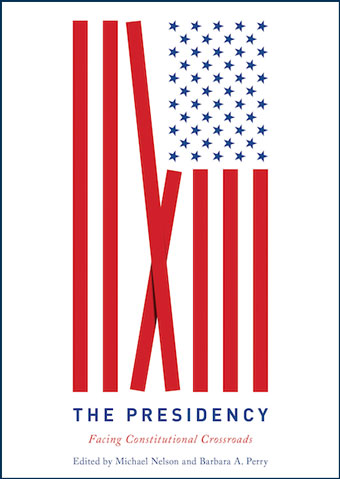The living presidency: Always at a crossroads
Is the living, imperial presidency a bug or a feature of the modern Constitution?
Excerpted from The Presidency: Facing a Constitutional Crossroads, edited by Barbara Perry and Michael Nelson, University of Virginia Press, 2021.
The presidency itself arose from the most consequential of crossroads, the Philadelphia Constitutional Convention. Although James Madison is often deemed the father of the Constitution, he was a perplexed uncle when it came to Article II. On the eve of the convention, Madison had apparently given little thought to the executive. In “Vices of the Political System of the United States,” he listed twelve “defects” of the Articles of Confederation. While noting the lack of sanctions for breaking national laws, he ignored the absence of a vigorous, independent national executive to enforce the laws. His April 1787 letter to George Washington, written a month before the Philadelphia Convention, sheds light on why: “I have scarcely ventured as yet to form my own opinion either of the manner in which [the national executive] ought to be constituted or of the authorities with which it ought to be cloathed.” This was a bit of an overstatement, for, as a reader of Baron de Montesquieu’s Spirit of the Laws, he would have known that an executive does what the label implies—it executes the law. In the eighteenth century, the word “executive” had a core meaning even if its margins were contested. For Madison to speak of an executive was to signal that he desired an entity tasked with implementing national laws. Yet despite his reputation for preparation, Madison was unsure about which additional “authorities” should be vested in the executive.
At almost every junction at the convention, the state delegations tilted toward an energetic executive.
 Some of Madison’s convention allies were far surer about the ideal features of the executive. Led by Pennsylvanians Gouverneur Morris and James Wilson, a group of delegates successfully willed into existence an independent and powerful executive. In the end, not all delegates endorsed its final contours. Three—Edmund Randolph, George Mason, and Luther Martin—pointedly criticized the formidable executive that emerged from the convention’s proceedings.
Some of Madison’s convention allies were far surer about the ideal features of the executive. Led by Pennsylvanians Gouverneur Morris and James Wilson, a group of delegates successfully willed into existence an independent and powerful executive. In the end, not all delegates endorsed its final contours. Three—Edmund Randolph, George Mason, and Luther Martin—pointedly criticized the formidable executive that emerged from the convention’s proceedings.
They had ample cause. Over the course of the convention, the executive crystallized into an American version of European monarchies, one whose resemblance to the British kingship could not be gainsaid. This republican, limited monarchy was hardly foreordained when the delegates first met in May 1787. Rather, the executive acquired power as the convention unfolded, a pattern of accretion that would become familiar to later generations.
At almost every junction at the convention, the state delegations tilted toward an energetic executive. The delegates settled on a single executive and rejected a triumvirate, presumably because they agreed with those who warned of violent dissensions and the diffusion of responsibility. After tussling for months over the vexatious question of selection, they settled on special presidential electors with a House backstop when no candidate received an electoral majority. This selection process, coupled with a guaranteed salary, a lengthy tenure, and no term limit, yielded an independent executive unbeholden to Congress.
In fact, the new executive—armed with a host of powers, some specifically enumerated and others part of the general grant of “executive power”—would serve as a counterweight to Congress. The executive would wield a check on legislation in the form of the limited veto, the power of which has grown as presidential confidence waxed over the centuries. Moreover, the president also would have power to enforce the law, the ability to pardon all federal offenses, an interstitial authority over foreign affairs, command of the military, and direction of the executive bureaucracy. With respect to making appointments and treaties, the president would need the Senate’s consent.
Why did the powers of the executive accrete over the course of the convention? Credit (or blame) George Washington and the determined delegates who relentlessly pressed for a robust executive. Washington’s sterling character caused those fearful of executive power to let down their guards. When delegates considered a unitary executive, they thought of Washington and were cheered by the prospect that he would be the first president. Had he not proven that power could be entrusted to him by renouncing it at the end of the Revolution? Those favoring a robust executive rode this Washingtonian tailwind and stubbornly persisted in their view that under existing frameworks, including the state constitutions and the Articles of Confederation, Americans had gone too far in hobbling the executive. The reformers insisted that this mistake be avoided at all costs. Unlike the weak, plural executives that often had been the norm, the new Constitution prized executive vigor and unity.
When Americans received the proposed Constitution, discerning minds peered behind the document’s trappings to see that the president would be far more powerful than contemporaneous state executives, whom James Madison had denigrated as “cyphers.” In the words of Edmund Randolph, in reading the Constitution, the people would behold a “little monarch,” imbued with more power than many of the crowned monarchies in Europe. Thomas Jefferson said the office was a “bad edition of a Polish King”—hardly words of flattery. His aide said the Constitution would create a “mixed monarchy,” for despite “the humble title of President,” the office “will have greater powers than several monarchs have.” Prominent Anti-federalists, like Patrick Henry and George Mason, carped that the presidency “squints toward monarchy” and that the Constitution would establish an “elective monarchy.” Some supporters of a strong executive rejoiced. For instance, John Adams was delighted that the Constitution had created a “monarchical republic.” Even foreigners saw the resemblance, with the Dutch stadtholder saying that Americans had given themselves a “king, under the title of President.”
The Founders were more sophisticated when it came to monarchy.
The complaints generally flowed in one direction. We the People ratified the Constitution in the teeth of innumerable claims that the presidency would have too much authority and be too monarchical. In contrast, precious few complained that the office would be impotent or lethargic. The Constitution thus marked a sea change from 1776, when the signers of the Declaration indicted George III for kingly excess in authority. In the Constitution, the convention had constructed something scarcely different from what the nation had previously forsaken. America was to have, in many respects, a national government, with a mighty executive at its head.
The monarchical cast of the original presidency is utterly lost on modern readers of the Constitution.
